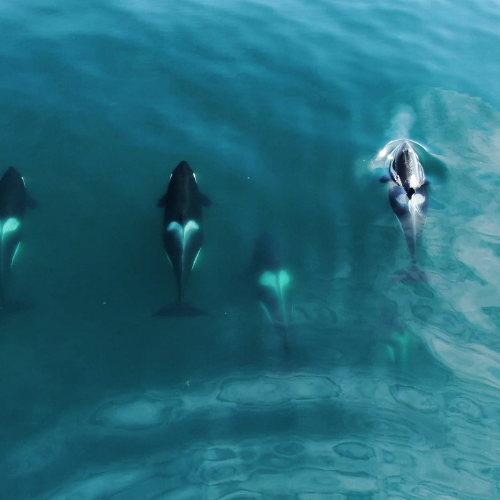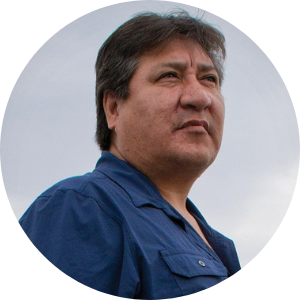Allies for Nature
A call for a Canada – U.S. agenda to support people and the planet
The doors have swung open to an alliance for nature.
Canada and the United States share a vast natural heritage of earth and forests, rivers and lakes, wetlands, grasslands, and coastal areas across the world’s longest international border. We share airways and trails, and a maze of corridors for spectacular annual migrations of whales, birds, caribou, and other wildlife.
Canada and the United States also share accelerating nature crises, as entire populations of species collapse, and the world inches closer to climate catastrophe.
As both countries promise to conserve 30 percent of land, freshwater, and ocean by 2030 by advancing Indigenous led conservation and supporting nature-based climate solutions, there exists a historic opportunity to work together to address the twin existential environmental crises of our time: species collapse and climate change.
Wildlife species don’t know borders. They don’t carry passports. Only 2,000 Monarch butterflies were counted this Winter in an area of California where millions used to migrate from Canada.There are precipitous declines in right whales, caribou, songbirds and many other species that cross our borders. Ecosystems such as forests and grasslands that safeguard our climate face increased threat from industrial expansion.
When biodiversity collapses, the web of animals and plants that support one another and our climate is torn apart until almost nothing can survive.
Canada and the United States share a responsibility to act.
Prime Minister Justin Trudeau has made the most important conservation commitment in Canadian history. He now has an ally in U.S. President Joe Biden, who has made significant commitments to goals shared by Canada for conservation, climate action, and species protection.
The doors are open to an alliance for nature.
Both governments have made the “30×30” pledge to conserve 30 per cent of land, freshwater and ocean by the year 2030. They both support Indigenous-led conservation. Nature-based climate solutions are on the agenda in each country.
Acting jointly on these commitments on both sides of the 9,000 km border would generate post-pandemic hope now and ensure a legacy for nature and for future generations.
There is a historic opportunity to work together to address the twin existential environmental crises of our time: species collapse and climate change.
Teaming up could also create a powerful influence on the international stage as the nature crisis joins climate at the top of the global environmental agenda.
Coordinated efforts to protect nature across Turtle Island, as some Indigenous peoples refer to North America, would help the whole planet.
A Canada-U.S. alliance could have a breakthrough impact for nature and the climate if bold joint action is pursued in three priority areas: Expand protections for ecological corridors and the species that rely on that habitat, support Indigenous rights and conservation, and advance nature-based climate solutions.
Nature Canada urges Canada and the United States to build towards a joint declaration on an alliance to maximize nature’s capacity to harbor biodiversity and safeguard our climate, and to establish the formal cooperation mechanisms that will move this agenda forward.

Section 1
Protect and connect ecological corridors
Some of the world’s most precious ecological corridors span the U.S. – Canada border, from mountain ranges in the West, to the Great Plains grasslands in the prairies, to seascapes off the three coasts and the boreal forest spanning Alaska to Newfoundland.
A Trudeau-Biden joint action plan to protect and reconnect fragmented corridors would support the safe movement of wildlife species for food, shelter, reproduction, and adaptation to a changing climate.
Nature can also be better protected by improving and coordinating stronger action through key policy and legal instruments. For example, rollbacks on migratory bird protections announced in the waning days of the Trump administration risk further declines in bird populations, which are already in free fall across North America, with three billion birds lost since 1970– an overall decline of 29 percent in this period.
Potential priorities for increased cross-border conservation include:
The landscape between Algonquin Provincial Park in Ontario and Adirondacks Park in New York State is important to many species at risk. There are protected areas between the two, but they are fragmented and need to be connected. Similarly, connecting and conserving areas within the forested, mountainous Northern Appalachian – Acadian region, stretching from New York to Nova Scotia, would support a rich web of wetlands, rivers, lakes, streams and bogs and the species that live in them.
This project seeks to protect the mountain range habitat that is home to such iconic species as grizzly bears and golden eagles, from the Yellowstone National Park in the state of Wyoming up to the Yukon Territory in Canada.
Spanning southern Canada to Mexico, it’s a globally significant swath of one of the most endangered landscapes on Earth, with significant potential for carbon storage and habitat for many species including the Central Flyway for migratory birds.
These coastlines provide significant opportunity to collaborate for protection of ocean corridors from sea floor to surface and revival of at-risk species. Resident orca whales live in waters from Alaska to central California. Endangered North Atlantic right whales swim more than 1,500 kilometres from feeding grounds in Canada to calve in warm waters in the southern United States.
Canada and the United States share the Great Lakes St. Lawrence ecosystem, home to 200 species at risk. The Columbia River, largest in the Pacific Northwest, flows into the Pacific Ocean. The Red River flows North from Minnesota to Lake Winnipeg. The Lake of the Woods and Rainy River Watershed spans the Ontario, Manitoba and Minnesota borders.
Section 1
Opportunities for action
- Invest in new and expanded protected networks of transboundary lands, freshwater and ocean to link fragmented corridors and preserve connected ecosystems as part of the pathway to meet 30×30 conservation goals.
- Coordinate joint measures to safeguard and recover species at risk such as the Porcupine Caribou herd, including protecting the Arctic National Wildlife Refuge.
- Prioritize and respond to conservation needs identified by existing binational governance bodies such as the International Joint Commission.
- Reinvigorate conservation action through the Commission for Environmental Cooperation and other North America wide mechanisms like the Grasslands Roadmap Summit, which brings together conservation groups, first nations, producers, and governments to plan and implement joint actions.
- Identify weaknesses and strengthen international agreements for nature protection such as the Migratory Birds Convention and the Canada-U.S. Great Lakes Water Quality Agreement.
- Support cross-border networks of local groups working on conservation corridors and work to promote and restore international hiking trails like the Pacific Crest Trail.
Section 2
Support indigenous rights and conservation
Supporting the rights of Indigenous peoples to govern and manage the lands and waters they have stewarded for millennia is central for reconciliation and the realization of the UN Declaration on the Rights of Indigenous Peoples.
Across the globe, the areas of highest value for biodiversity and climate regulation are on lands managed or co-managed by Indigenous communities. Learning from and collaborating with Indigenous governments and communities is therefore essential to Canada-U.S. cooperation in conserving large transboundary landscape corridors.
We need to create a new paradigm by braiding the best parts of traditional and scientific knowledge to change our relationship with each other and with Mother Earth

The Canadian government supports the creation of Indigenous Protected and Conserved Areas and Guardian programs. These programs, also recently started in Alaska, support Indigenous people to care for their lands and community using traditional knowledge and science.
“The guardian programs literally transform people’s lives and communities,” says forester Valerie Courtois, Director of the Indigenous Leadership Initiative. “… By honoring the cultural responsibility to the land, Indigenous Peoples are strengthening our communities and expressing our nationhood.”
President Biden has committed to working with Tribal governments for conservation goals and appointed Rep. Deb Haaland, the first Native American cabinet secretary, to the Department of the Interior, the key office for establishing protected areas.
“A voice like mine has never been a Cabinet secretary or at the head of the Department of Interior,” she said in a message pinned to the top of her Twitter feed. “Growing up in my mother’s Pueblo household made me fierce. I’ll be fierce for all of us, our planet, and all of our protected land. I am honored and ready to serve.”
Section 2
Opportunities for action
- Support the establishment of Indigenous-protected areas and Guardian programs to manage these areas within the United States and Canada, including possible cross-border initiatives.
- Promote dialogue and learning across nations and borders on the facilitation of Indigenous-led conservation and climate planning.
Section 3
Advance nature-based climate solutions
We need to work together to connect the dots between the stress climate change is placing on species and ecosystems, and nature’s capacity–from forests to farms–to store carbon.
Just as degradation of nature generates greenhouse gas emissions that fuel global warming, healthy forests, peat bogs, wetlands, grasslands, and oceans are also natural carbon sinks, absorbing and storing greenhouse gases. ‘Blue carbon’ ecosystems, such as saltmarsh and seagrass, may sequester carbon at higher rates than terrestrial ecosystems.
Restoring and defending these natural habitats helps prevent wildlife loss, cools cities, and boosts resilience against sea-level rise, river flooding, extreme fire weather and severe land degradation.
Canada’s Work to Date
The Canadian government has made protecting and restoring nature a pillar of its climate policy, starting with investing $3.9 billion over ten years to unlock the power of nature to reduce emissions, notably by planting two billion trees over a decade. This is just the beginning of what’s needed.
Canada and Mexico have already worked closely for two years co-leading the “nature-based solution action track” for the Global Commission on Adaptation initiative created to bring attention to nature’s role in climate adaptation.
Forests and Nature-Based Solutions
President Biden’s executive orders on climate change also feature nature-based solutions, citing the need to limit greenhouse gas emissions related to land-use change, forests, and agriculture and recognizing the importance of reducing emissions from sectors like forestry to meet decarbonization goals.
Canada and the United States must reform the way they monitor, calculate, and report emissions from industrial logging to better represent the industry’s impact and to place the industry under a carbon pricing regime to encourage climate-friendlier logging practices. This has particular application in the Canadian Boreal forest, which contains over 300 billion tons of carbon– as much carbon as the world emits over 36 years.
Section 3
Opportunities for action
- Invest in transboundary restoration and protection initiatives that make ocean and freshwater coasts more resilient to climate change while increasing the carbon sequestration ability of ecosystems like wetlands, grasslands, forests, saltmarsh and seagrass.
- Undertake a joint commitment to fully capture and mitigate carbon impacts in North America’s forests through improved forest management, monitoring and accounting. This should include joint investments in on-the-ground monitoring and the establishment of a bilateral commission of policymakers and experts to harmonize forest carbon monitoring, accounting and science on the basis of best scientific and international practices.
